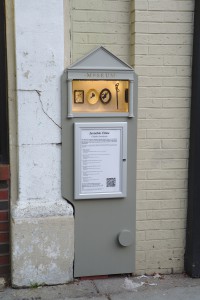
The Mµseum is a space for showcasing masterful, engaging, and innovative work on an intimate scale with a focus on art being produced in New England. We work to make art physically and psychologically accessible by presenting it in a familiar, low-pressure environment, while bringing a sense of wonder to the urban landscape.
What is that funny-looking “u”?
“µ”—pronounced “mew” (mŷː)— is a Greek letter whose scientific meaning is “micro”. The Mµseum is a pretty tiny art museum—possibly the smallest in the world! (and we can’t resist a pun).
Source (or, why a focus on local art?)
Somerville, Massachusetts, home of the Mµseum, has the second highest number of artists per capita of any city in the United States. That’s JUST Somerville. There is an incredible amount of artistic talent in New England. Much like the local food movement, we feel that when looking for art to exhibit, its good practice to start by looking in your own backyard. We will show the art we are most excited about, that we find the most compelling, and that we feel best expresses the ideas we are trying to convey. That being said, we’ll start by looking at work being produced in New England. To continue the food analogy, a market that focuses on locally sourced foods might have the occasional import that they feel complements their selection, but why ship a tomato from across the country when the one grown in your own city is just as delicious?
Accessibility
Way too often people reject the idea of checking out art for fun because art isn’t something they “understand.” Yet more steer clear of commercial galleries because of the pressure to buy, or the feeling of being watched or out of place.
We want art to be something that is approachable to everyone. By bringing art right up to the viewer, in an unstaffed, pressure-free environment (a place you’d be anyway, just walking down the street!), we hope to make art both physically and psychologically approachable.
Who We Are
Judith Klausner (Co-Founder, Curator) is a Somerville MA artist with a love for small, intricate, and overlooked things. She first dreamed up the Mµseum in 2010, as a way to combine her love of serious miniature art with her passion for making art accessible, and her conviction that New England arts institutions should show the work of New England artists. Three years (and a lot of planning) later, she is delighted to see it become a reality. Judith received her degree in Studio Art from Wesleyan University in 2007 after constructing her thesis primarily out of insects (all of which were already dead), and has since continued to search the details of her surroundings for inspiration. She enjoys playing with her food, both recreationally and professionally.
Contact Judith at judith@tinymuseum.org
Steve Pomeroy (Co-Founder, Engineer) is a programmer and a builder, both by profession and by nature. He’s largely responsible for the engineering behind the Mµseum, from the solar-powered miniature track lighting to the 3D-printed doric columns and laser-cut façade typography. He formally studied computer science at the Rochester Institute of Technology where he discovered a love of communication protocols and formal computer languages.
Contact Steve at steve@tinymuseum.org
Open Source
In keeping with our goal to make The Mµseum accessible to all, we also want to share what we’ve learned and created so others can build upon it. The Mµseum has many physical components to it, a good number of which we had to custom design. Below are some resources we created that are made available under open source/free software/free culture licenses.
- The Mµseum github respository – this is the main repository for all the parts of The Mµseum that we’re making publicly available. While it’s the source, some of the other resources below provide more instructions and images.
- Miniature LED track lighting – 3D models, instructions, and photos of the miniature track lighting.
- IKEA LEDBERG bar strip sockets – 3D models, instructions, and photos of the connectors that let us create flexible joints between individual LEDBERG strips.